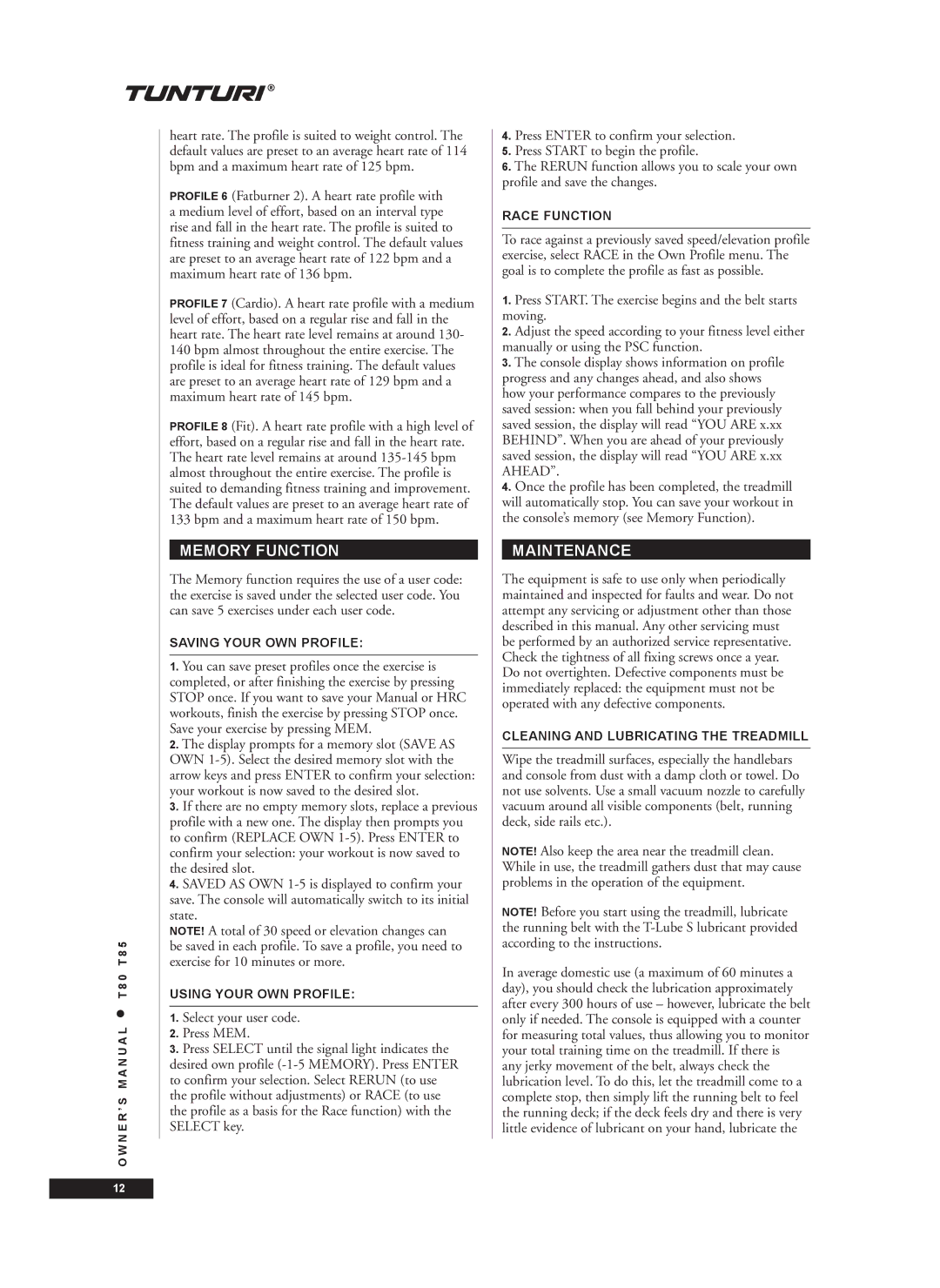T80 T85
Käyttöohje
Contents
Assembly
Before assembling the device, insure all parts are present
Running base
Fasten each handrail to the lower frame with four bolts
T80 / T85
Basics on Exercising
Heart Rate
Console
Starts the selected training and activates the running belt
Finishing AN Exercise Session
10 %, 0,5 % increment
00-99.99 km, 0,01 km increment
Displays
Graphic / Text Display
Position Speed Control PSC
Choosing AN Exercise
Manual Exercise
Heart Rate Controlled Exercise
Fitness Tests
KM Walking Test
Exercise Profiles
Cooper Test
Profiles
Maintenance
Memory Function
Adjusting the Belt Tension
Error Codes
Malfunctions
Alignment of the belt is correct
Technical Data
Moving and Storage
Wichtige Sicherheitshinweise
Montage
Prüfen Sie, dass folgende Teile vorhanden sind
Laufunterlage
Vorderstangen
Handstütze UND Cockpit
Laufunterlage
Sicherheitsschlüssel
Allgemeines ZUM Training
Herzfrequenz
Cockpit
Fortgeschrittene 60-70 % der maximalen Herzfrequenz
Beginnen Sie mit der gewählten Trainingseinheit
Anzeigen
GRAFIK/TEXTANZEIGE
Eingabe DER Benutzerangaben
Schalten Sie die Verwendung der Tonsignale
Wahl DER Trainingseinheit
MANUAL-TRAINING
Herzfrequenzgesteuertes Training
Schnellstart
Mit den Pfeiltasten
Konditionstest
KM Gehtest
COOPER-TEST
Trainingsprofile
Profile
Die Abbildungen finden Sie am Ende dieser Anleitung
Speicherfunktion
Speichern Eines Eigenen Profils
Verwendung Eines Eigenen Profils
Wettkampffunktion
Wartung
Lang laufen. So wird das Schmiermittel gleichmäßig verteilt
Reinigung DES Laufbandes UND Pflege DER Laufplatte
Ausrichten DER Laufmatte
Betriebsstörungen
Transport UND Aufbewahrung
Das Cockpit zeigt eine Funktionsstörung auf der Anzeige an
Nachspannen DER Laufmatte
Technische Daten
T80 Foldaway Länge 210 cm
Höhe 142 cm
Conseils ET Avertissements
Assemblage
Piste
Barres D’APPUI Avant
REPOSE-MAINS ET Compteur
Piste
CLE DE Verrouillage DE Securite
Cordon D’ALIMENTATION
Généralités SUR ’ENTRAÎNEMENT
Rythme Cardiaque
Unite DES Compteurs
Heart Rate pouls d’entraînement
Affichages
GRAPHISME/AFFICHAGE DE Texte
Réglage DES Données Utilisateur
Vitesse Contrôlée PA Positionnement PSC
Training Avec LA Fonction PSC
Choix DE L’ENTRAINEMENT
Manual Entrainement Manuel
Entrainement PAR Controle DE LA Frequence Cardiaque
Quick Start Démarrage Rapide
Appuyant sur la touche Start
Test DE Condition Physique
LE Test DE Marche 2 KM
Test DE Cooper
Profils D’ENTRAINEMENT
Test commence Test Started
Profils
Fonctions DE LA Mémoire
Validez votre sélection en appuyant sur la touche
En conditions d’utilisation normale maximum
Reglage DE L’ALIGNEMENT DU Tapis
Reglage DE LA Tension DU Tapis
Defauts DE Fonctionnement
Transport ET Rangement
Coder D’ERREUR
Caracteristiques Techniques
Opmerkingen EN Adviezen
Controleer of de verpakking alle onderdelen bevat
Loopmat
Voorleuningen
Handsteun EN Meter
Looponderstel
Fitness Training
Nadat u de handsteun en de meter gemonteerd heeft
Noodstop
Elektriciteitssnoer
Hartslag
Over DE Ruimte Waar U Traint
Over HET Gebruik VAN DE Apparatuur
Beginnen MET DE Training
Meter
Toetsen
Functies
Instelling VAN Gebruikergegevens
Trainingskeuze
Manuele Training
Hartslagaangepaste Training
Conditietest
KM Looptest
Regelen met de snelheidstoetsen of de SPEED-toets
Het testresultaat bij de gebruikte snelheid
Na 12 minuten geeft de meter een geluidssignaal
Loopsnelheid zelf regelen met de snelheidsknoppen. Let
Trainingsprofielen
Profielen
Geheugenfunctie
UW Eigen Profiel Opslaan
Wedstrijdfunctie
Onderhoud
PSC-functie wijzigen
Reiniging EN Smering VAN DE Looptrainer
Gebruiksstoringen
Storingen
HET Centreren VAN DE Loopmat
HET Spannen VAN DE Loopmat
Transport EN Opslag
Technische Gegevens
Avvertenze
Assemblaggio
Tappeto
Il montaggio, segui le seguenti istruzioni
Barre D’APPOGGIO Anteriori
Corrimano E Contatore
Tappeto DEL Treadmill
Chiave DI Sicurezza
Cavo PER LA Corrente
Allenamento
Battito Cardiaco
Pannello
Tasti Funzione
Display
Inserimento Dati Utente
Ángulo de inclinación, 0-10 %, con intervalli di 0,5 %
Controllo Velo Cità DA Posizione PSC
Scelta DELL’ESERCIZIO
Esercizio in Manual
Esercizio a Controllo Pulsazioni Cardiache
Avvio dopo l’inserimento del codice utente
Avvio Rapido
Il programma chiede nel campo di testo il sesso
Il programma chiede nel campo di testo l’età AGE
Dell’utente inserire la propria età, utilizzando i tasti
Alla fine dei 12 minuti, il pannello emetterà un
Profili DI Esercizio
Profili
Funzione Memoria
Le foto sono riportate nella copertina di fondo
Memorizzazione DEL Proprio Profilo
Manutenzione
Inserire il codice utente Pressare il tasto MEM
Utilizzo DEL Proprio Profilo
Funzione Competizione
Codici Disfunzioni
Allineamento DEL Nastro
Regolazione Della Tensione DEL Nastro
Disturbi Durante L’USO
Spostamento ED Immagazzinaggio
Dati Tecnici
Información Y Precauciones
Montaje
Compruebe si en los embalajes están todas las piezas
Superficie de carrera
Barandillas Delanteras
Manillar Y Contador
Superficie DE Carrera
Llave DE Seguridad
Cable DE Alimentación
Aspectos Generales DEL
Aspectos generales del entrenamiento
Ritmo Cardíaco
Contador
Teclas de función
El ejercicio elegido se pone en marcha
Pantallas
Monitor Gráfico Y DE Texto
Introducir LOS Datos DE Usuario
Control DE Velocidad POR LA Posición PSC
En la pantalla aparece el texto Press Enter
Selección DEL Ejercicio
Ejercicio Manual
Ejercicios DE Ritmo Cardíaco Constante
Prueba Para Medir LA Condición Física
Test DE Caminata DE LOS 2 KM
Perfiles DE Ejercicio
Inicio DE LA Prueba DE Marcha
Prueba DE Cooper
Automáticamente el ejercicio, tras el cual
La cinta se detendrá. Es posible guardar el
Ejercicio en la memoria del contador véase
Función de memoria
Perfiles
Función DE Memoria
Almacenado DE SU Propio Perfil
Mantenimiento
Utilización DE SU Propio Perfil
Modo Competición
Limpieza Y Lubricacion
Defectos DE Funcionamento
La cinta esté bien alineada
Poner en marcha la cinta a 5 km/h
Datos Técnicos
Traslado Y Almacenaje
Anmärkingar OCH Varningar
Montering
Börja med att packa upp och kolla att du har följande delar
Löpunderlag
Handtag OCH Display
Löpunderlaget
Allmänt OM Träning
Koppla alltid av strömmen efter varje träningspass
Puls
Börja Träningspass
Avsluta Träningspass
Mätare
Visning PÅ Skärmen
Inställning AV Användaruppgifter
Uppskattad energiförbrukning 0-9999 kcal i steg om 1 kcal
VAL AV Träning
MANUAL-TRÄNING
Pulsstyrd Träning
Konditionstest
KM Gångtest
Träningsprofiler
Coopers Test
Profiler
Service
Minnesfunktion
Centrering AV Löpband
Justering AV Löpbandets Spänning
Störningar VID Användning
Koder FÖR FEL
Transport OCH Förvaring
Tekniska Data
Huomautukset JA Varoitukset
Asennus
Juoksualusta
Etukaiteet
Käsituki JA Mittari
Juoksualusta
Yleistä Harjoittelusta
Laitetta saa käyttää vain sisätiloissa
TURVA-AVAIN
Verkkojohto
Huomioitavaa Laitteen Käytöstä
Harjoituksen Aloittaminen
Harjoituksen Päättäminen
Syke
Mittari
Näytöt
Käyttäjätietojen Asetus
MANUAL-HARJOITUS
Sykeohjattu Harjoitus
Kuntotesti
Harjoittelu Pscn Kanssa
Valmiit Harjoitusprofiilit
Juoksualustan kulma säätyy automaattisesti 1 %
KM Kävelytesti
Cooperin Testi
Profiilit
Muistitoiminto
Kilpailutoiminto
Huolto
Ruiskuta voiteluainetta 5 sekunnin ajan
Juoksumaton Puhdistus JA Huoltovoitelu
Maton Keskittäminen
Käyttöhäiriöt
Kuljetus JA Säilytys
Tekniset Tiedot
Pituus 210 cm
112
Profiles
T80,T85 Foldaway
T80, T85 Foldaway
T80, T85
T80, T85
5834030 C

